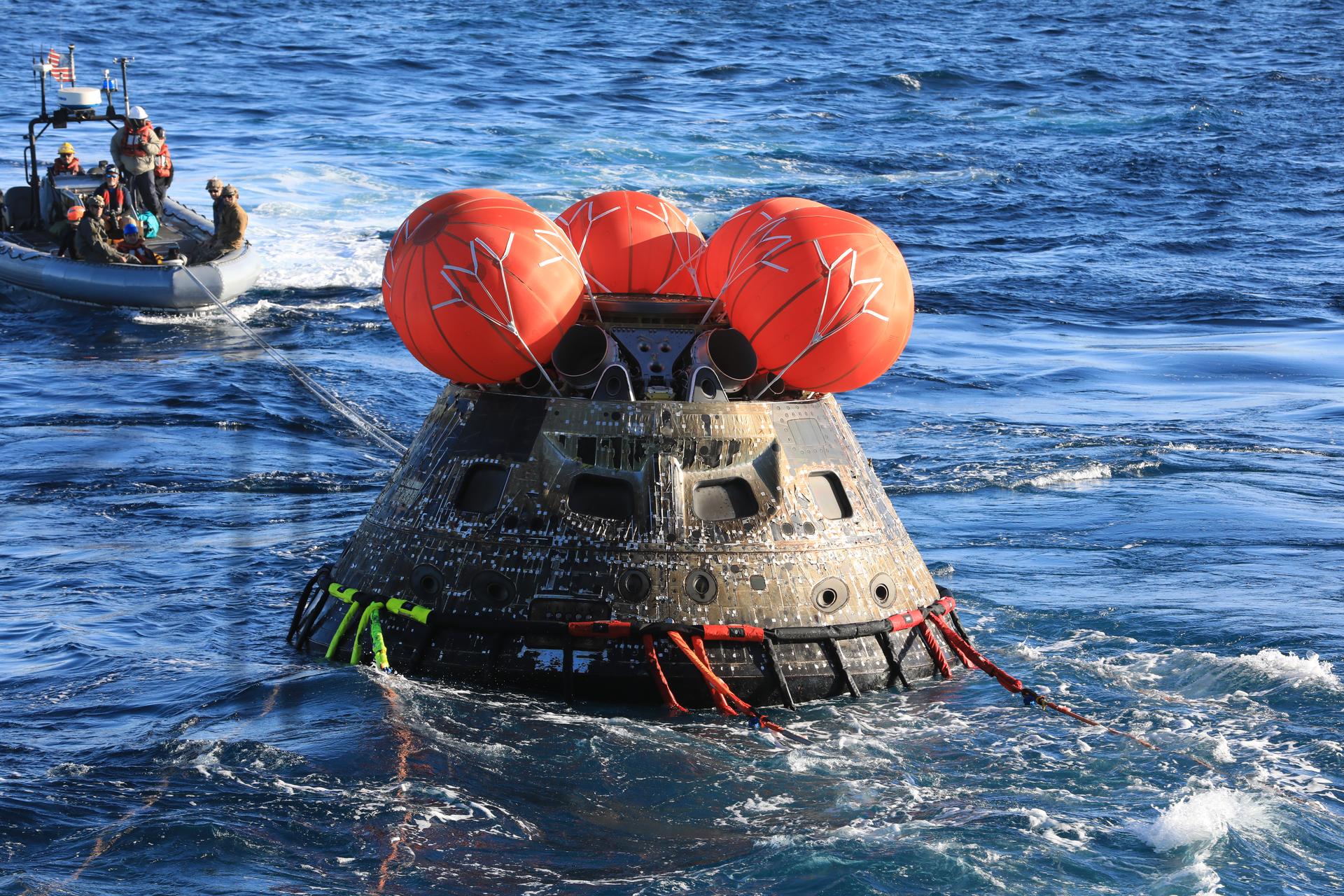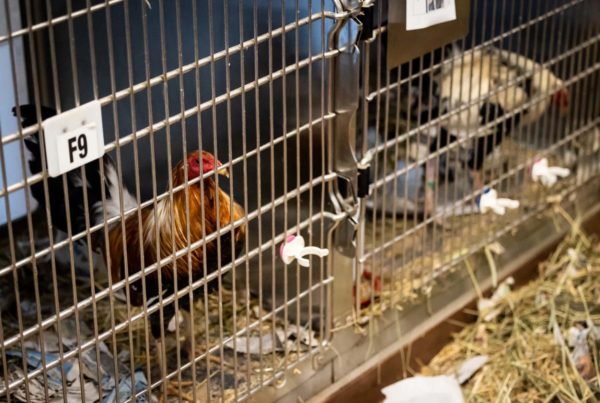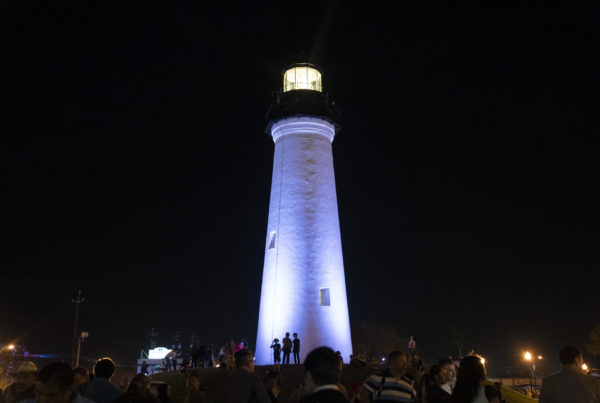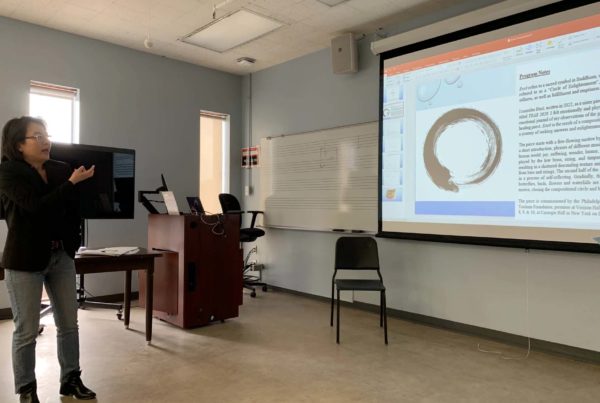NASA’s Orion capsule marked the end of a successful 25-day mission Sunday when it splashed down in the waters off Mexico’s Baja Peninsula.
The spacecraft’s successful return to Earth marked further progress in the agency’s Artemis program aiming to return humans to the moon, 50 years since the last Apollo flight ended
Eric Berger, who covers space for tech site Ars Technica, joined the Standard to talk about the milestone and where NASA goes from here. Listen to the story above or read the transcript below.
This transcript has been edited lightly for clarity:
Texas Standard: Let’s start with Orion’s return yesterday. How did it go?
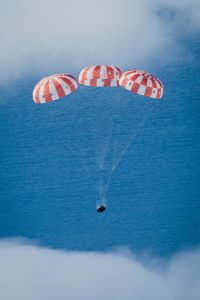
At 12:40 p.m. EST, Dec. 11, 2022, NASA’s Orion spacecraft for the Artemis I mission splashed down in the Pacific Ocean after a 25.5 day mission to the Moon.
Josh Valcarcel / NASA
Eric Berger: It went really well. This is a large spacecraft: It has a mass of about three elephants. It’s pretty big across, and it’s got to burn off a lot of energy when it’s coming back to the moon. It’s traveling at Mach 23 – 23 times the speed of sound – and it has about 10 or 15 hours to burn that off as it flies through the atmosphere. And so NASA was really keen to test this heat shield, which effectively burns away as it passes through the atmosphere, and then the parachute system. And it splashed down in the Pacific Ocean right on schedule. It looked like there was no damage to the vehicle. So it really puts them in a good position as they look to fly humans in Orion next time.
The mission began almost a month ago when Orion, after several delays, took off from Florida. What were some of NASA’s goals for the mission?
The big goals really were to demonstrate the capability of the space launch system rocket, which flew pretty much flawlessly. It delivered the spacecraft right where NASA wanted it to, and that’s pretty impressive for the debut launch of that vehicle. And then Orion spent more than three weeks flying around the moon. And NASA put it through its paces. It did a lot of testing of the thrusters on board the vehicle to make sure that they would turn on and turn off when needed. It was really an impressive demonstration.
You wrote yesterday about how Artemis is succeeding in the political realm in ways previous attempts to revive deep space flight have not. What are a couple of the reasons things have worked out this time around?
It’s really been a lot of missteps since the Apollo program as NASA’s tried to get back into space. But it’s a couple of things. First of all, there was a pretty good agreement in Washington, D.C., that it was time for NASA to go back into deep space, especially with the rising threat of China and then their plan to send their astronauts to the moon about a decade from now. And so there’s interest from that sense. There’s the commercial space industry, which has come along and is helping to bring down the costs associated with spaceflight. And it was just some pretty clever work by Vice President Mike Pence and the administrator of NASA, Jim Bridenstine, to put together a political coalition and then one of industry, as well, and to bring international partners in. So I’m talking about European countries, Japan, Canada, some developing nations as well, to sort of put together a broad bipartisan plan.
So what’s still needed to land humans on the moon?
Yeah, so NASA has illustrated the rocket and the spacecraft capable of flying astronauts into deep space. But there’s still some pretty critical elements at work, and a lot of that work is actually being done here in Texas.
The lunar lander is needed – so a vehicle basically to take the crew down to the lunar surface, allow them to go outside and then come back and then blast off back up to lunar orbit where they’ll rendezvous again with Orion. And that contract has actually gone to SpaceX in the Starship Vehicle, which is being tested in South Texas. There’s a lot of work left to get that vehicle flying and then to demonstrate a bunch of different capabilities you would need before NASA says it’s safe enough to put astronauts on it and send them down to the moon. Because if Starship can’t get back up off the moon, then the crew doesn’t survive. So it’s really a critical piece of technology. And then also there’s the spacesuits that the astronauts will need to do spacewalks on the surface of the moon. And those are actually being developed by a company in Houston called Axiom Space.
And so the goal for NASA is to have those elements ready by the end of 2025 for mission. I think that’s pretty optimistic. But, you know, we’re probably looking at a lunar landing later this decade. We’re going to probably get the names of the four astronauts who are going to fly on Artemis 2 next spring. So just a few months from now, we’ll know who’s going to go. There’ll be four of them on Orion flying around the moon, but we won’t probably see them launch for another two years at least, as NASA’s still got to install a lot of the life support equipment inside Orion, do a bunch of testing on that. They’ve got to remove some hardware from the spacecraft that just flew and put it on the new vehicle.
And as I say, it’s going to be a couple of years. But, you know, really with the technical performance we saw over the last month from Orion and the SLS rocket, that mission is definitely going to happen. The future is pretty bright for NASA from a human exploration standpoint. It’s certainly as bright as I’ve seen in my career covering the industry.


